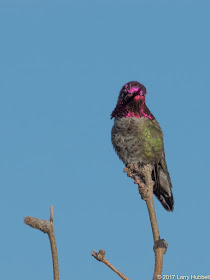While visiting family in Lake Havasu City, I photographed my first Geococcyx californianus or greater roadrunner. They are native to dry areas all across the southwest. Their behavior is quite different than any bird I have seen around Union Bay.
From the front, the roadrunner appears fairly light in color. When ruffled, it is easy to see that the inner portion of the neck feathers are very dark, as is its crest. Roadrunners have strong pair bonds and mate for life.
The second roadrunner I saw initially had its back to me so it appeared much darker. I suspect the dark colors make them harder to see against an asphalt road. It makes me wonder if roadrunners will evolve to be darker in areas with more pavement.
I cannot find any information to confirm whether coyotes are the roadrunner's primary nemesis - as in the childhood cartoons - but the birds certainly do love to run.
I was surprised to learn that the male roadrunner can make a cooing call, which sounds similar to a dove. You can hear one on All About Birds by Clicking Here and then scrolling down. None of the calls recorded on the website sound at all like the cartoon character.
This particular bird ran across my mother's patio and then down into a small natural area below the house. My mother's home is surrounded by city streets and houses in nearly every direction. Clearly, these bird can adapt to city life if sufficient food and natural areas are present.
Against the dry brush and shadows, the camouflaged colors of the californianus help it to fade into its surroundings.
The exception is the dark feet against the light rock, which certainly caught my attention. Roadrunners have two toes forward and two pointed backward, like a woodpecker. I suspect this helps to maximize its traction and control especially when running.
I found its elevated claws a bit surprising. After thinking about it, it seems logical to hold the talons up so the points do not get dulled by the rocks. It may also help them to approach their prey quietly - they would not want to make clicking noises like a pet dog's claws on a kitchen floor.
Did you note the slight hint of blue just above the eye?
Here you can see that the talons remain in the elevated position even when the bird is moving.
If I had not been tracking the roadrunner when it moved, I doubt I would have been able to pick it out against this background.
My first impression was that roadrunners are similar in size to pileated woodpeckers. It turns out that roadrunners are just slightly longer, but can weigh up to twice as much and generally have a one third smaller wingspan, according to All About Birds. The extra weight and shorter wingspan may explain why this species prefers to hunt by running instead of flying.
Roadrunners eat all of the small desert creatures which you might expect - like birds, lizards and mice. They also eat scorpions and even rattlesnakes. An average rattlesnake can be four feet long and easily weigh four or five times as much as a roadrunner. I did not see such an encounter, but I have read that one roadrunner will distract the snake while its mate pecks at or grabs the snake by the back of the head. Roadrunners are known to bash their prey's head against a rock to finish it off.
Currently on eBird, the northern most, west coast sightings of roadrunners are to the north of the San Francisco Bay. Who knows, if global warming continues they may one day end up running around Union Bay.
Larry
Going Native:
Without a functional Environmental Protection Agency, it falls to each of us to be ever more vigilant in protecting our local environments. Native plants and trees encourage the largest diversity of lifeforms because of their long intertwined history with local, native creatures. I have been told that even the microbes in the soil are native to each local landscape. My hope is that we can inspire ourselves, our neighbors and local businesses to plant native flora and to support native wildlife at every opportunity. My intention is to include at least one photo each week and visually challenge us to know the difference between native and non-native lifeforms.
Which of the following birds species, photographed in Lake Havasu City, AZ, are also native to Union Bay?
1)
2)
3)
4)
5)
6)
7)
8)
9)
10)
1) Ruddy duck, female
2) Great-tailed grackle, male
3) Ring-billed gull
4) House finch, male
5) Black phoebe
6) Anna's hummingbird, male
7) Mourning dove
8) Verdin, male
9) Turkey vulture
10) Gambel's quail, male
Native to Union Bay:
1) Ruddy duck, female
3) Ring-billed gull
4) House finch, male
7) Mourning dove
9) Turkey vulture
Not native to Union Bay:
2) Great-tailed grackle, male
5) Black phoebe
8) Verdin, male
10) Gambel's quail*, male
*At this angle, the dark forehead clearly distinguishes this bird from a California quail.
Debatable:
6) Anna's hummingbird, male
Historically the Anna's hummingbird was not native to Union Bay. In recent decades it has expanded north from California, apparently because of the increasing availability of food near human homes, e.g. feeders and flowers. There is fear that it may be displacing the native rufous hummingbird which historically has migrated north to our area during warm weather to breed and reproduce.










































































